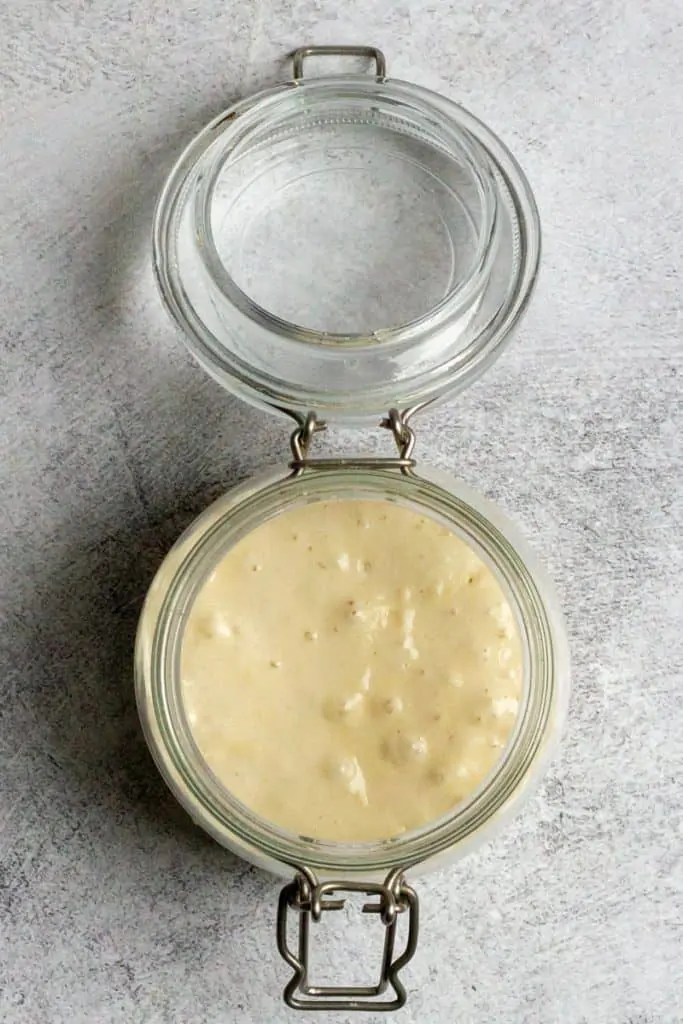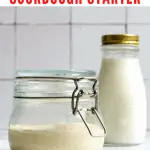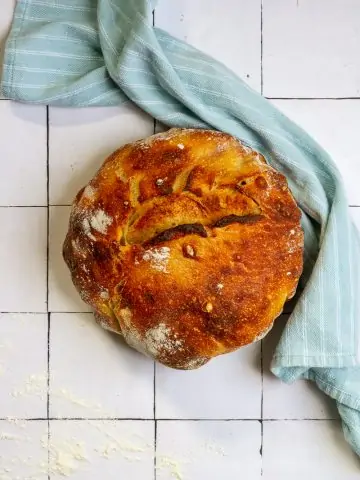Want to get started with sourdough? Try this extra quick and easy milk kefir sourdough starter that's ready in about one day!

Long before the sourdough craze of 2020, I found myself struggling to make a sourdough starter.
I followed tutorial after tutorial, but nothing worked.
I even (impatiently, but hopefully) continued feeding my brand-new baby starters for weeks. And yes, I said "starters," because I was trying more than one technique at once.
More recently, my friend Sally walked me through making a sourdough starter with simply flour and water, and was confused when (just like before) nothing happened.
This was all especially frustrating because I ferment things all the time! I'm constantly brewing kombucha and hard kombucha, and love keeping milk kefir on hand.
At some point, we started to wonder if my other ferments were somehow stopping the sourdough starter from growing.
Sally suggested using one of my fermented drinks as a starter liquid instead of water, and that technique worked beautifully. And it was fast!
Were the well-established live cultures in my other ferments preventing new cultures from flourishing? I don't know for sure, but that's my current best guess.
This easy milk kefir sourdough starter is ready to use within about 24 hours and produces a gorgeous, bubbly starter.
Interested in other ferments? Try making homemade sauerkraut, red cabbage sauerkraut, fermented garlic, Instant Pot yogurt or yogurt machine yogurt.
What is Milk Kefir?
Milk kefir is a fermented milk drink made using milk kefir grains and milk.
Check out my full milk kefir tutorial here, or buy active milk kefir grains on Amazon to get started.
Can I Use Water Kefir?
Unflavored water kefir should work too! It's also a fermented drink with lots of active microbes.
I'm not currently fermenting water kefir, so I wasn't able to test this one out myself.
Can I Use Kombucha?
Yes! I've also got directions for a kombucha sourdough starter.
Can I Use Store-Bought Kefir?
Maybe.
You'll likely get the best results from homemade milk kefir, but if you can find store-bought unflavored kefir with live cultures (or live probiotics), it will (probably) work.
I've never seen unflavored water kefir at a grocery store, so you'd probably only try that version with homemade.
What Is Sourdough?
Sourdough is an ancient method of naturally leavening flour. It uses wild yeast and lactic acid in the environment to encourage microbe growth.
It's a great alternative for store-bought yeast, and is thought to be easier to digest than other types of bread.
Eating sourdough can also help encourage a healthy gut microbiome.
If you're into sourdough for the health benefits, know that store-bought sourdough isn't always fermented. Sometimes (often) it's made with yeast that imitates the flavor profile of sourdough.
What's a Sourdough Starter?
Similar to a kombucha SCOBY or an apple cider vinegar mother, a sourdough starter helps keep the healthy microbes growing in the sourdough.
You'll need to keep the sourdough starter happy and healthy by feeding it regularly.
Traditionally, sourdough starters are made with simply flour and water.
Some sourdough starter techniques attempt to jump-start the starter growth by adding non-pasteurized juice or organic fruit. This version uses kefir to help speed things up.
Will a Milk Kefir Sourdough Starter Taste Different?
Yes and no.
Yes, in that each sourdough tastes a little different.
Sourdough grows using the wild yeast and lactic acid in your own environment, meaning that even if you use a gifted or purchased starter, it will eventually change flavors depending on its current environment.
And no, in that no matter what type of sourdough starter you use initially, your starter will eventually develop its own unique flavors.
No-Maintenance Sourdough Starter
Do you love the idea of sourdough but aren't into the commitment?
This sourdough starter works quickly and is perfect for anyone who isn't ready to take care of a starter.
For a no-maintenance starter, simply use the entire starter in your bake and start over next time you want sourdough.
Can I Make a Gluten-Free Milk Kefir Starter?
Yes, you can!
You'll get varying results depending on the type of gluten-free flour you use. I've successfully made this starter with rice flour.
Since gluten-free starters can be harder to maintain than wheat-based starters, the no-maintenance version of this starter might be a great option.

How to Make a Milk Kefir Sourdough Starter
If you're already familiar with a traditional sourdough starter technique, this one simply swaps water for milk kefir.
Mix together 2 ounces of flour with 2 ounces of milk kefir. Add the mixture to a glass jar (or mix it in the jar).


Let it rest in a semi-warm (but not hot) spot.
Within 12 hours, you should see some bubbling. It might even be ready to use.
After 24 hours, you'll likely see lots of bubbling. If it's doubled in size (or simply a lot larger than before), it's ready to use.

Is it Ready for Bread Recipes in 1 Day?
Probably not.
Instead, the starter should be active with a nice flavor within one or two days. At this point, you can begin using the starter in sourdough discard recipes.
Some of our favorite discard recipes are these pancakes: sourdough blueberry pancakes, sourdough oatmeal pancakes, sourdough pumpkin pancakes and gluten-free sourdough pancakes!
To use with bread, you'll want a very active starter. Continue following the maintenance steps in the recipe card below until your starter is very bubbly and active.
It should double in size and (ideally) pass a "float test." Do the float test by pinching off a small piece of starter and checking to see if it floats in water. If it sinks, keep feeding your starter.

You can check to see how big your starter is getting after feeding by adding a rubber band to the jar. Place the rubber band at the level your starter begins at, and then watch it grow above the rubber band line.
Once your starter is very active, try making Dutch oven sourdough bread, sourdough cinnamon bread and rosemary garlic sourdough bread.
Can I Maintain This Starter With Water?
Yes, absolutely.
There's no need to continue feeding the starter more milk kefir, because the cultures are already live and active. Simply feed it with flour and water.
That said, if your starter ever becomes sluggish or doesn't seem to be as healthy as it used to be, try reviving it by feeding it with milk kefir and flour (instead of water and flour).
Milk Kefir Sourdough Starter
Equipment
- 1 glass jar
Ingredients
Initial Starter Materials:
- 2 ounces flour (~½ cup, measure by weight if possible) See "Flour Tips" Recipe Notes
- 2 ounces milk kefir (plain with live cultures) See "Milk Kefir" Recipe Notes
Starter Maintenance (Optional):
- 2 ounces flour (~½ cup, measure by weight if possible) Use same flour as original starter, or slowly transition to another type of flour
- 2 ounces non-chlorinated water (¼ cup)
Instructions
Initial Starter:
- In a clean glass jar, whisk together the flour and milk kefir. (I like to use a fork to whisk.) The mixture should be the consistency of pancake batter. If yours is much thicker, add a little more kefir to thin it out, or if it seems very thin add more flour. (I've found rice flour needs slightly more kefir.)Cover the jar. (Cover can be loose or air-tight, see "container tips" recipe notes.)Store jar in at room temperature (about 70°-75° F).

- Stir the flour and kefir once or twice a day, until the starter is bubbly and has doubled in size. Your starter should be ready to use within about 24 to 48 hours. You should have approximately 1 cup of starter.

- No Maintenance Starter: You can proceed to use the entire batch in a recipe, skipping any starter maintenance, and simply remake the starter as desired. This is a nice option if you don't want to maintain a starter, or if you're using a gluten-free flour that may be difficult to maintain."Float Test" for Bread: Once the starter has doubled in size and is bubbly, it should have a nice enough flavor to use the discard right away in discard recipes. To test if the starter is ready for bread, pinch of a small piece of the starter and drop it in water. If it floats, it can be used in bread. If it doesn't, proceed to the starter maintenance stage and keep feeding the starter until it passes the float test.

Starter Maintenance:
- Discard the starter down to 2 ounces (~½ cup). You can use the discard in a "discard" recipe.Whisk together 2 ounces of flour, 2 ounces of water and 2 ounces of starter. Note that from this point on, you can feed the starter with water instead of milk kefir.Cover the jar, whisking once or twice a day. When the starter is bubbling and doubled in size, repeat the process. Continue discarding and feeding once a day, or place into storage until ready to use again.To store the starter: Feed the starter and then move it immediately into the fridge. Remove from the fridge and allow the starter to warm up for a few hours before using. Depending on how long the starter was in the fridge, it may take a few days to become very active again. Ideally, feed starter at least once a week even when in storage.

Notes
- Unbleached all-purpose flour is perfect for your starter. It's less finicky than some other flours.
- Gluten-free flours (such as rice flour, sorghum flour, millet flour and arrowroot flour) will work to varying degrees, but may be much more difficult to maintain. Avoid using gluten-free flours with xanthan gum (a thickening additive). Avoid using nut flours (such as almond flour), as these likely will not work.
- If possible, use organic flour. It will be easier for the good bacteria to grow with organic flour.
- Use plain, unflavored milk kefir with live probiotics.
- This technique will likely work best with homemade milk kefir.
- Do not add milk kefir grains to the flour, only the liquid kefir.
- This technique should also work with unflavored water kefir, but I haven't personally tried that.
- Use non-chlorinated water. (Chlorine will discourage, or even finish off, the good bacteria you're trying to grow.)
- Non-filtered tap water is generally chlorinated. I use a reverse osmosis filter for my water, but filtered water should work just fine.
- If your kitchen is cold, your sourdough starter may struggle to get started. Try placing your starter somewhere warm (like on top of your fridge).
- For a cold kitchen, try using warm (not hot) water for your starter maintenance. Hot water can ruin your starter.
- My preference is to loosely cover the jar. You can use a paper towel and a rubber band, or a jar with a non-air-tight lid. I use a swing-top jar with the rubber seal removed.
- If you use a loosely fitting lid, you may find that your sourdough starter will sometimes develop a thin skin on top. This is simply dried-out dough. You can peel it off or stir it back in, but it won't harm your dough (or your baked goods).
- If you choose to ferment or store your sourdough in an air-tight container, make sure that there is plenty of room for the dough to expand. If the jar is too small, the sourdough could burst out of the jar (or even bust the jar itself), creating quite a mess.
- Keep it clean. Make sure to always use clean utensils and jars when working with sourdough. Contaminating the dough can cause problems.
- Liquid on top of the starter. If you see liquid on top of your starter, it's called hooch. Drain it off and feed your starter immediately. I've typically only had problems with hooch when I was adding too much liquid to the starter.
- Measure the flour by weight if possible. Ideally, use a digital scale, but I've had success with even a cheap analog scale. One cup of all-purpose flour does not weigh the same as one cup of whole wheat flour, so it can be harder to know how much liquid to add without using a scale. If using unequal amounts of flour and water, you could have problems with hooch (see above), or simply less consistent results.







Eliza
I followed your recipe. All looks good until day 5 when it became active with lots of bubbles and triple in volume. I wasn't ready to bake so I continued to feed but since then it has been flat with no activity. Looks and smells ok. It's day 7 today. What happened and what should I do?
Alisha Trenalone
Hi Eliza! You could try feeding it with milk kefir and flour again, instead of water and flour. Also, just make sure, are you weighing the ingredients (if possible)? And using unchlorinated water? Hope this helps! Let us know how it goes.
-Alisha at Champagne Tastes
Eliza
HI Alisha. I learned so much from your blog. Thanks for the advice, the starter is active again. Hope to build a strong starter. THANKS.
Alisha Trenalone
Yay, glad it's active again!
SS
Hello - Love this idea to try a gluten free oat flour starter.
Are there safety concerns with letting a dairy product sit at room temp for so long?
I have a bread machine with a ferment setting of 86 deg f and also a yogurt maker 110 deg f. Would eitherof these help?
Thank you!!
Alisha Trenalone
Hello! Thanks for your questions. If the milk kefir has live active cultures there shouldn’t be any problem leaving it at room temperature. (Milk kefir is fermented at room temperature.)
We haven’t tried using a bread machine with a ferment setting, I typically just use a jar on the countertop so that I can keep an eye on the bubbles forming easily. However 68 degrees is a great temperature to do this at, so that should work (especially if your home is considerably warmer or cooler).
The yogurt machine setting is too warm, I would not use that for sourdough.
Let us know how it goes with the oat flour!
-Alisha at Champagne Tastes
Diana
Worked like a charm using AP flour and homemade milk kefir. After initial rise, I discarded and then used AP flour and water so it would not smell so much like sour milk. First loaf w/this starter had excellent oven spring. This is a find! Thank you.
Alisha Trenalone
Fantastic! Thanks so much for letting us know 🙂
-Alisha at Champagne Tastes
Angela
Hi I am interest in making my bread with the Kifer and four starter but when I went to the sourdough recipe it didn’t seem to mention using the original Kifer and flour.
When I tried the starter it rose beautifully but then thought I’d better continue to feed instead and that didn’t work well.
My question is can I just use the Kifer and flour starter for the sourdough bread. That would suit my life.
Alisha Trenalone
Hi, Angela, you can refer to the "Initial Starter" Instructions, step 3. If your starter passes the "float test" (explained in the step), you could use it in bread. Otherwise you'll need to go onto step 4 (starter maintenance) before it's ready.
Hope this helps!
-Alisha at Champagne Tastes
Kath Bennett
is starter made from Kefir the same as 'normal' sourdough starter? Will it produce gluten free sourdough and does it behave the same or is it a different culture?
thanks
Alisha Trenalone
The kefir sourdough starter has different microbes getting the starter going, but should behave exactly like a water-based sourdough starter.
Gluten comes from the flour used, not from the liquid in the starter. Check out our gluten-free sourdough starter if that's what you're looking for.
-Alisha at Champagne Tastes